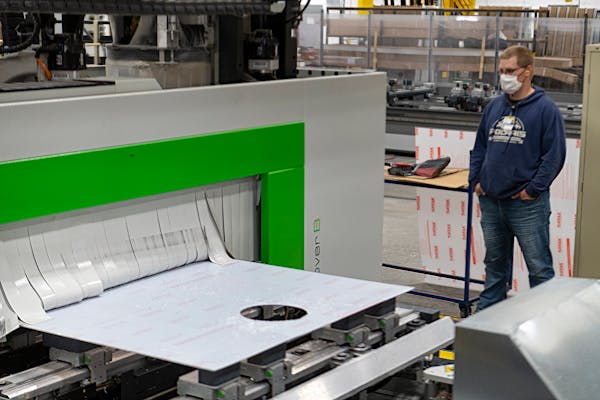Sophia Haug paused a beat, trying to think of one of her friends who is not working. She couldn't.
The 18-year-old was surrounded by other teens supervising preschoolers who were whacking plastic balls and drawing pictures on Wednesday. Some staff at Blaine's summer playground program are working to earn spending money. Others had parents who urged them to get a job. Several plan to teach and wanted experience working with kids. Most are saving for college. All earn at least $15 an hour.
More teenagers are joining Minnesota's workforce — and not just in summer jobs — as employers, desperate for workers in a tight labor market, entice them with record-high wages.
"If you are planning to go to a four-year [school], you really do need to work," said Haug, who is in her third summer working for Blaine's PlayNet program. She has seen parents push high schoolers who were stuck at home during the pandemic to get jobs. "The cost of living has gone up. And I think parents want to ensure their kids know how to work once they leave the house."
The teen unemployment rate in Minnesota was 7.3% in June, up slightly from last year but still comparatively low, and their labor force participation continues to climb, according to new state jobs numbers released Thursday. Minnesota's overall unemployment rate for workers of all ages remained unchanged at 2.9%, and 9,017 more people joined the labor force last month.
Nationally, the unemployment rate this year among people ages 16-19 is the lowest it's been since the early 1950s, data from the Bureau of Labor Statistics shows.
When COVID-19 hit, many older workers left customer service jobs out of fear for their health or because they were able to move into higher-paying positions, said Oriane Casale, with the labor market information office at the Minnesota Department of Employment and Economic Development (DEED).
"All of these recreation jobs and retail trade jobs and leisure and hospitality jobs suddenly opened up, and employers were willing to hire teens because, you know, they were available," Casale said. "It was exactly those customer-facing type of jobs that teens are most qualified for that were really super available."
Teens see 'fantastic' wages
Teens typically worked about 11 hours a week and earned a median hourly wage of $15, according to a recent report Casale authored that analyzed data from summer 2022. She found the median wage for teens jumped 13.4% over the previous year, nearly double inflation and far more than the 6% wage growth for Minnesota workers overall.
Teens held 7.3% of all jobs in Minnesota, she reported, the highest percentage since the Great Recession. Labor force participation for young people plunged as a result of that recession, as many of the jobs they traditionally filled were taken by older, more experienced workers laid off from other positions. And it remained low for years.
Teens are very conscious of what their friends are doing, and if they hear it's hard to find work, many won't even look for a job, Casale noted. But, she said, when some members of their social group start earning money, it seems they all want in.
"All of a sudden their friends are like, 'Oh, I'm going to work too!'" she said. "When there are more jobs available for them, when they are easier to get, then they tend to go into the labor market and bring all their friends with them."
Jessica Lipa, career and technical education director for Anoka-Hennepin School District, has seen youth employment climbing for years. After taking a brief hit during pandemic, she said, it really surged.
"That's when inflationary costs really hit families hard and employers really started to raise their wage," she said. "The wages have been fantastic for kids."
She sees three big reasons for the employment jump. Some kids must work to support their family or have a little spending money. School districts across Minnesota are expanding work-based learning programs to connect students with potential careers. And employers, including manufacturing companies, that might not have considered people younger than 18 in the past are now reaching out to them to fill spots, Lipa said.
Many businesses hiring teens also take strategic steps to get them to stick around, she added — from paying more than $20 an hour to helping cover tuition to ensuring they feel like part of the organization.
Too many jobs, too few teens
While more teens are getting jobs, there are still not enough of them to meet demand.
Cities are struggling to fill lifeguard spots. And the Mall of America — where teens make up the majority of employees at attractions like Nickelodeon Universe — is working hard to entice young workers.
The mall offers incentives including tuition reimbursement, sign-on and referral bonuses and paid time off for part-time employees, said Jill Renslow, MOA's executive vice president of business development and marketing. Currently 30% of all mall employees are teenagers, up from 27% last year.
Employers said they must act fast on teens' applications. In the past, the city of Blaine would review all of the applicants for summer parks and recreation jobs and line up a certain day or two to do all the interviews. That's no longer an option.
"If an application comes in, you have to interview that teenager right away. And if they are good and you want them, you have to get them booked," said Jerome Krieger, Blaine's senior parks and recreation manager.
Wait a day or two, and the worker may have already accepted a different position, he said.
"There [are] a lot of kids that are interested in jobs," Krieger said. "But there have been so many jobs out there, and so many opportunities, that if you hesitate, you fail."
Tractor-trailers with no one aboard? The future is near for self-driving trucks on US roads
Affluent Americans are driving US economy and likely delaying need for Fed rate cuts
South Korea's opposition leader urges the president to accept investigation of wife, top officials
Insider Q&A: Avelo Airlines CEO Andrew Levy describes the challenges of starting a new carrier

